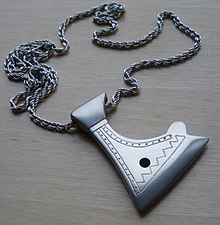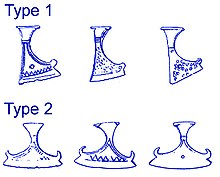Axe of Perun
The Axe of Perun, Hammer of Perun or Molnia / Mjolnir, also called a "hatchet amulet", is an archaeological artifact worn as a pendant and shaped like a battle axe. The Amulet is named after Molnia (Cyrillic: Молния), and is a counterpart to a Nordic Mjolnir amulet. It is mostly found in modern day Russia, Ukraine, Belarus, Poland and parts of Scandinavia. Connection with the Slavic pre-Christian god Perun was made by VP Darkevich, although some authors prefer the association with Norse material culture.[1]
Amulet description[edit]

The axes range in length from 4 to 5.5 cm, and blade width from 2.8 to 4 cm. Bronze is the most common material of their construction. Most have been dated between the 11th and 12th century, and over 60 specimens have been collected.
Two basic designs of the axe have been found throughout Russia and its boundaries.
Specimens of both designs include a hole in the centre of the blade, and both have been decorated with zigzag lines, representing lightning or more likely imitating inlaid ornamentation patterns of real axes, near the edge of the blade.
- Type 1
The first type is a bearded axe (lower side of the blade is elongated) with a flat upper side. It resembles a battle axe. A knob-like protrusion is usually present on the lower side of the axe. These axes have been decorated with circles, believed to represent celestial bodies.
- Type 2
The second type is distinguished by its symmetrical shape and broad blade. Similar to the knob of the first type, the second has two horn-like protrusions diametrically opposite on the upper and lower side.[2]
See also[edit]
Further reading[edit]
- Древнерусские амулеты-топорики ("Ancient Axe Amulets", in Russian)
- P. Kucypera, S. Wadyl "Early medieval miniature axes of Makarov’s type 2 in the Baltic sea Region"
References[edit]
- ^ "Early medieval miniature axes". www.academia.edu. Retrieved 2015-11-04.
- ^ "Древнерусские амулеты-топорики". Organizmica.org. Retrieved 2015-11-04.
